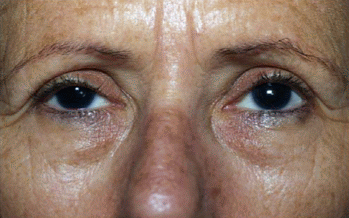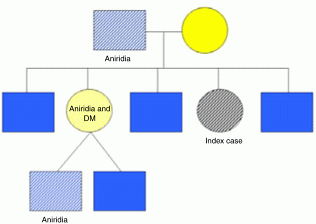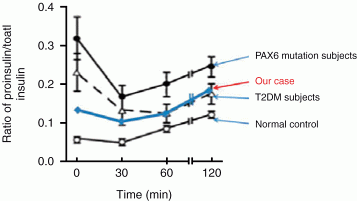ICEECE2012 Poster Presentations Diabetes (248 abstracts)
A novel case of diabetes mellitus and aniridia in a Caucasian family
D. Chen 1, , A. Jenkins 2, & L. Campbell 1,
1St Vincent’s Hospital, Sydney, New South Wales, Australia; 2Garvan Institute of Medical Research, Sydney, New South Wales, Australia; 3University of Wollongong, Wollongong, New South Wales, Australia.
Introduction: We describe a novel case of familial congenital aniridia in a Caucasian woman with associated insulin requiring diabetes mellitus. This human combination has been described in Asian families in association with a heterozygous Paired Box 6 (PAX6) mutation (1) with subsequent evidence supporting that the mutation in this transcription factor causes decreased Proconvertase 1/3 function in the pancreas and a high proinsulin to insulin ratio (2). Our case does not have a PAX6 mutation and study ratios of proinsulin to insulin were not consistent with impaired conversion.
Clinical case:: A 54-years-old woman of Caucasian descent was diagnosed with diabetes mellitus aged 28. She commenced a basal-bolus regimen soon after diagnosis, currently taking <20 units insulin per day. She has a HbA1C of 7.5% without microvascular complications. Her body mass index is 21 kg/m2. Recent glutamic acid antibody and islet cell antibody tests were negative.
The patient has congenital bilateral aniridia with subsequent bilateral cataracts. She has an intraocular lens implant in her left, and a contact lens in her right eye. There is a significant family history with her father having aniridia without diabetes, her sister having aniridia with poorly controlled diabetes, renal failure, and severe retinopathy, her nephew having aniridia alone.
Conclusions: Up to 10% of congenital aniridia cases do not have identifiable PAX6 mutation (3). This could be due to genomic alterations in regulatory elements of PAX6 or a mutation in another gene known to cause congenital iris abnormality (4). An ocular developmental gene forkhead box C1 (FOXC1) heterozygous mutation (W152G) has been suggested to produce aniridia in man by resulting in failed autophagy of poorly folded proteins (5).
We postulate that this mechanism could offer another means by which the beta cell may be vulnerable in man and should be sought in PAX6 negative aniridia cases with diabetes.
References:: 1. Yasuda T, et al. 2002. Diabetes Care. 51:224–230.
2. Chen JHW, et al. Diabetologia 2009, 52:504–513.
3. Lee H, et al. Acta Ophthalmol 2008; 86:708–15.
4. Khan A. et al. Molecular Vision 2011; 17:708–714.
5. Ito YA et al. Investigative Ophthalmology & Visual Science 2009; 50 (8): 3573-3579.



Top: Congenital bilateral aniridia Middle: Family tree Bottom: Meal study ratios of proinsulin to insulin were not consistent with impaired conversion
Declaration of interest: The authors declare that there is no conflict of interest that could be perceived as prejudicing the impartiality of the research project.
Funding: This research did not receive any specific grant from any funding agency in the public, commercial or not-for-profit sector.






